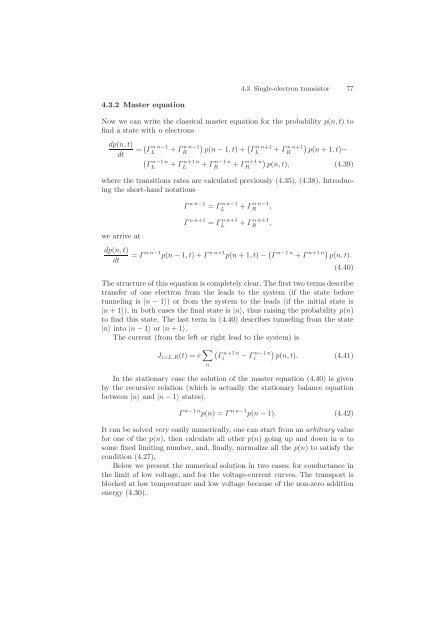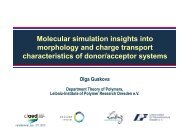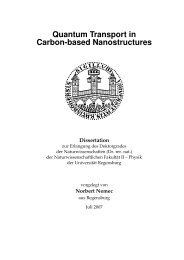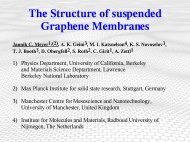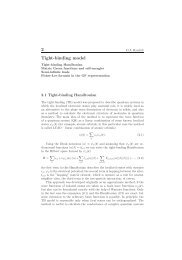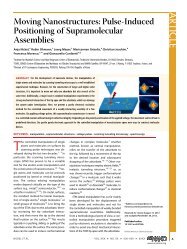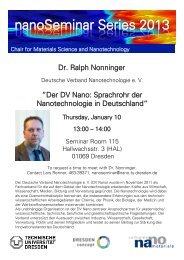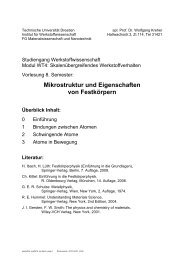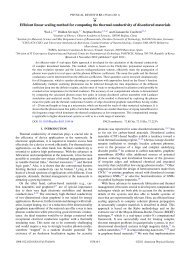4 Coulomb blockade
4 Coulomb blockade
4 Coulomb blockade
Create successful ePaper yourself
Turn your PDF publications into a flip-book with our unique Google optimized e-Paper software.
4.3.2 Master equation<br />
4.3 Single-electron transistor 77<br />
Now we can write the classical master equation for the probability p(n, t) to<br />
find a state with n electrons<br />
dp(n, t)<br />
dt<br />
= Γ nn−1<br />
L + Γ nn−1<br />
nn+1<br />
R p(n − 1,t)+ ΓL + Γ nn+1<br />
R p(n +1,t)−<br />
n−1 n n+1 n n−1 n n+1 n<br />
ΓL + ΓL + ΓR + ΓR p(n, t), (4.39)<br />
where the transitions rates are calculated previously (4.35), (4.38). Introducing<br />
the short-hand notations<br />
we arrive at<br />
dp(n, t)<br />
dt<br />
Γ nn−1 = Γ nn−1<br />
L<br />
Γ nn+1 = Γ nn+1<br />
L<br />
+ Γ nn−1<br />
R ,<br />
+ Γ nn+1<br />
R ,<br />
= Γ nn−1 p(n − 1,t)+Γ nn+1 p(n +1,t) − Γ n−1 n + Γ n+1 n p(n, t).<br />
(4.40)<br />
The structure of this equation is completely clear. The first two terms describe<br />
transfer of one electron from the leads to the system (if the state before<br />
tunneling is |n − 1〉) or from the system to the leads (if the initial state is<br />
|n +1〉), in both cases the final state is |n〉, thus raising the probability p(n)<br />
to find this state. The last term in (4.40) describes tunneling from the state<br />
|n〉 into |n − 1〉 or |n +1〉.<br />
The current (from the left or right lead to the system) is<br />
Ji=L,R(t) =e <br />
n<br />
Γ n+1 n<br />
i<br />
− Γ<br />
n−1 n<br />
i<br />
p(n, t). (4.41)<br />
In the stationary case the solution of the master equation (4.40) is given<br />
by the recursive relation (which is actually the stationary balance equation<br />
between |n〉 and |n − 1〉 states).<br />
Γ n−1 n p(n) =Γ nn−1 p(n − 1). (4.42)<br />
It can be solved very easily numerically, one can start from an arbitrary value<br />
for one of the p(n), then calculate all other p(n) going up and down in n to<br />
some fixed limiting number, and, finally, normalize all the p(n) tosatisfythe<br />
condition (4.27).<br />
Below we present the numerical solution in two cases: for conductance in<br />
the limit of low voltage, and for the voltage-current curves. The transport is<br />
blocked at low temperature and low voltage because of the non-zero addition<br />
energy (4.30).


